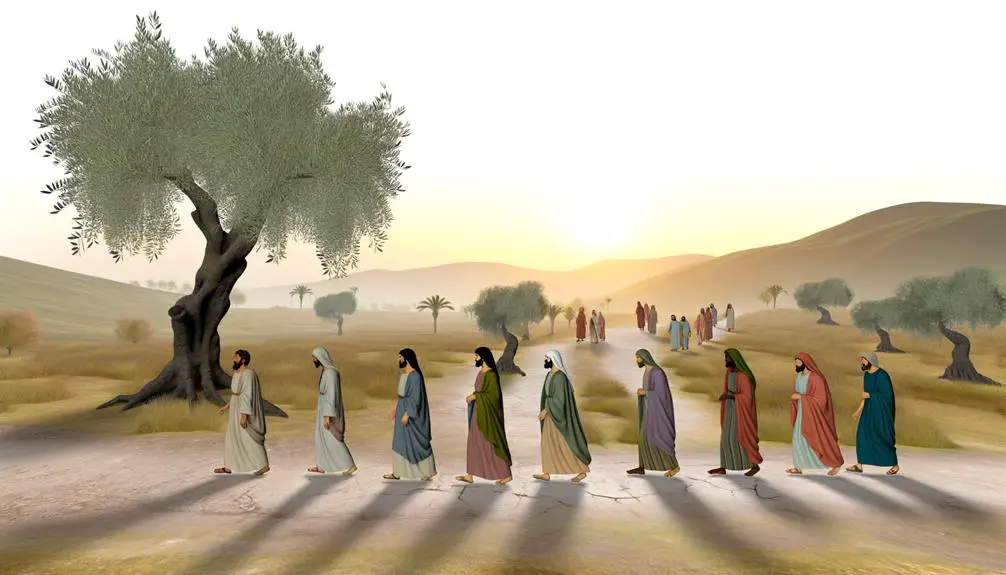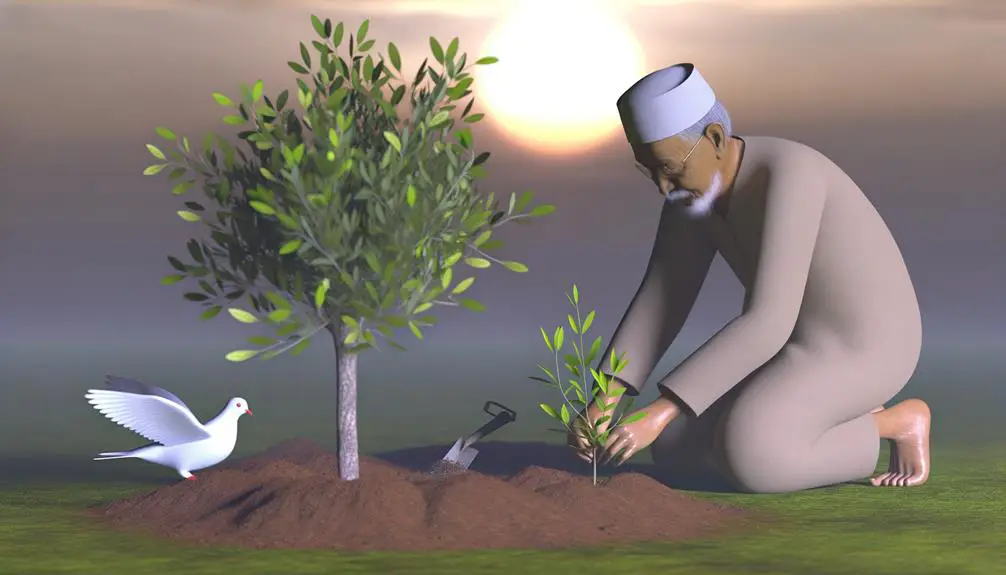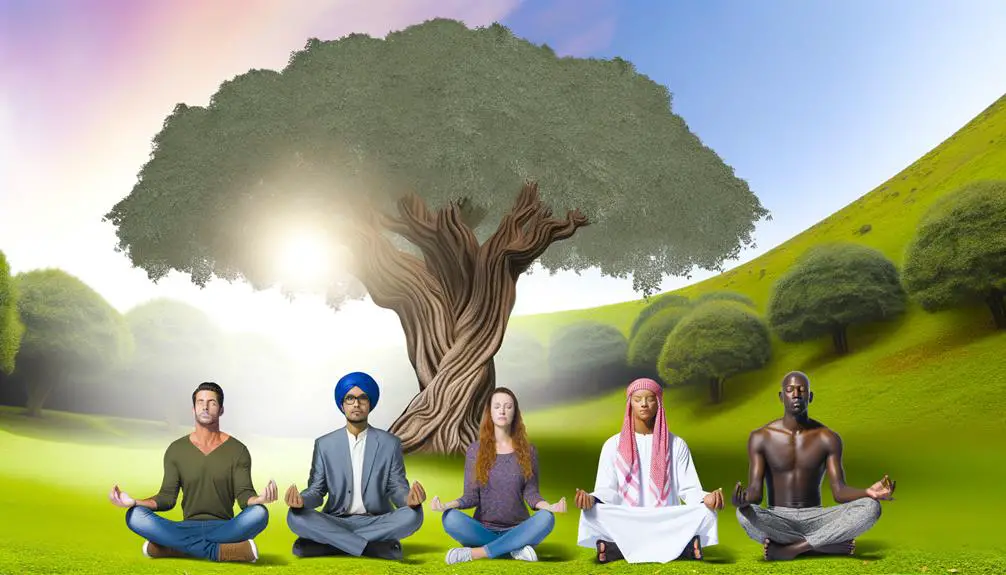Navigate the biblical virtue of longsuffering, exploring its role in depicting God's grace and patience amidst human imperfections—discover more inside.

Define Longsuffering in the Bible
In the Bible, longsuffering reflects God's enduring patience and gracious tolerance of human faults and failings. It's used to describe a virtue that combines persistence, patience, and mercy despite adversities or suffering. This attribute is visible in both Old and New Covenants, portraying God's unwavering fidelity and also as a key characteristic of Jesus Christ's teachings. Paul further elevates it as a fruit of the Spirit, essential for personal spiritual growth and the fostering of communal harmony. Understanding longsuffering as presented in biblical texts offers profound insights into handling life's challenges with grace and resilience, setting the stage for deeper exploration into its practical applications.
Key Takeaways
- Longsuffering in the Bible refers to enduring patience and tolerance for suffering, often seen as a divine quality.
- It is depicted as a critical attribute of God's nature, demonstrating His persistent fidelity and patience.
- In the New Testament, longsuffering is highlighted as a fruit of the Spirit, essential for Christian living and spiritual maturity.
- Biblical figures like Job, Abraham, and Moses exemplify longsuffering through their steadfast faith and patience in trials.
- It is foundational in the dynamics of forgiveness, promoting grace, emotional resilience, and relational healing.
Origins of Longsuffering

To understand the origins of longsuffering, you must explore ancient scriptural texts, where it's often depicted as a divine attribute. The concept's linguistic roots trace back to various ancient languages, where terms convey enduring patience and a tolerance for suffering over extended periods. This foundational understanding is important as it shapes the early religious and philosophical interpretations of longsuffering.
The cultural influences on the development of this virtue are equally significant. In many ancient societies, enduring personal hardships without complaint was seen not only as a spiritual duty but also as a significant social practice. This virtue was often encouraged among followers as a means of maintaining harmony and order within communities. Such cultural norms were then reflected in the scriptural texts of these societies, embedding longsuffering as a key ethical and spiritual principle.
Analyzing these texts, you can see how longsuffering was not merely an individual practice but a communal ideal, aimed at fostering resilience and moral fortitude across generations. This intersection of linguistic expression and cultural expectation provides a detailed picture of how longsuffering emerged as a pivotal attribute in ancient spiritual narratives.
Longsuffering in the Old Testament
In the Old Agreement, longsuffering emerges as a profound attribute of God, exemplified through His enduring patience with humanity's repeated failings. You'll find that this characteristic is not merely an emotional response but a strategic facet of divine interaction. It's woven intricately into the fabric of God's dealings with Israel, illustrating not just patience, but a steadfast commitment to the covenant despite human disobedience.
The concept of prophetic patience is vividly portrayed through the lives of prophets like Jeremiah and Isaiah. They didn't just prophesy about future events; they embodied longsuffering by persistently warning, guiding, and staying committed to a people who frequently strayed from their covenantal obligations. This endurance is a testament to God's character, mirrored in His messengers.
Moreover, Covenant endurance is central to understanding longsuffering in the Old Agreement. It reflects God's unwavering promise to His people. Despite Israel's cycles of rebellion, repentance, and restoration, God's commitment remained unshaken. This relentless fidelity highlights longsuffering not as mere forbearance but as active, persistent love and faithfulness.
Thus, in your exploration of biblical themes, recognizing these dimensions of longsuffering enriches your comprehension of how deeply it's embedded in the narrative of God's relationship with humanity.
Longsuffering in the New Testament

Moving to the New Covenant, you'll notice that longsuffering continues to be a critical attribute, particularly in the teachings and life of Jesus Christ. This virtue, rooted deeply in love and patience, is exemplified by Christ and is a cornerstone in Paul's teachings. It's more than mere patience; it's a profound form of spiritual endurance that involves bearing injustices and hardships gracefully, without losing faith or resorting to despair.
Paul explicitly emphasizes longsuffering as a fruit of the Spirit, which is essential for maintaining unity and peace within the Christian community. Here's a detailed look at how Paul integrates longsuffering into his epistles:
Epistle |
Reference to Longsuffering |
|---|---|
Ephesians |
Ephesians 4:2 |
Colossians |
Colossians 1:11-12 |
2 Corinthians |
2 Corinthians 6:4-6 |
1 Timothy |
1 Timothy 1:16 |
In these passages, longsuffering is linked not only to personal spiritual growth but also to communal harmony. It's about enduring wrongs while continuing to embody kindness and mercy. This attribute fosters deeper relationships within the Christian community, enhancing spiritual endurance. Thus, longsuffering is pivotal in cultivating a resilient faith that can withstand the trials and tribulations of life.
Biblical Figures and Longsuffering
Several biblical figures exemplify longsuffering, demonstrating how this virtue shapes personal character and influences divine relationships. You can see patience exemplified in the life of Job, who despite immense suffering and loss, maintained his faith in God's goodness and justice. His story is a profound exploration of enduring faith under extreme distress, providing a template for spiritual perseverance.
Similarly, Abraham's long journey of faith, marked by years of waiting for God's promises to materialize, illustrates longsuffering. His willingness to endure these delays, without losing confidence in God's plan, underscores a deep-seated trust and patience that is instructive for you today.
Moses also embodies longsuffering through his leadership of the Israelites. Leading a frequently discontented and disobedient group through the wilderness for forty years required not just strategic patience but a profound resilience anchored in faith. Each setback on their journey tested his resolve, yet his commitment to God's directives never wavered, showcasing how longsuffering is integral to effective leadership and spiritual maturity.
These examples illuminate how longsuffering is not merely passive endurance but an active, faith-driven response to challenges. This virtue, as seen through these figures, is pivotal in nurturing a robust spiritual life and fostering a closer, more resilient relationship with the divine.
Longsuffering and Forgiveness

Building on the theme of longsuffering, it's important to explore how this virtue intertwines with the capacity for forgiveness in scriptural narratives. Longsuffering, a profound patience amidst trials, serves as a foundation for the grace dynamics essential in forgiveness processes. You'll see that in biblical contexts, longsuffering isn't merely enduring others passively; it's an active, deliberate choice to withhold judgment, allowing time for personal and relational healing. This interplay between longsuffering and forgiveness is essential for developing emotional resilience.
Virtue |
Description |
Biblical Example |
|---|---|---|
Longsuffering |
Enduring patience in difficulties |
Job's perseverance |
Forgiveness |
Cancelling a debt or grievance |
Joseph and his brothers |
Grace Dynamics |
The movement from judgment to mercy |
Jonah's mission to Nineveh |
Emotional Resilience |
Ability to recover from emotional distress |
David after Absalom's betrayal |
Healing |
Restoration of personal and communal relationships |
Reconciliation of Esau and Jacob |
These elements, when woven together, illustrate how scriptural figures exemplify longsuffering by not only bearing injustices or trials but also by actively engaging in forgiveness. This synthesis enhances communal bonds and personal growth, showcasing the profound impact of enduring love and mercy.
Contemporary Implications
How does the biblical principle of longsuffering translate into modern contexts, particularly in fostering enduring interpersonal relationships and community resilience? In today's fast-paced, high-pressure environment, the application of longsuffering is vital yet challenging. Modern stressors, such as technological disruptions, economic uncertainties, and social conflicts, test your patience and endurance daily. These pressures necessitate a deeper understanding and application of longsuffering to maintain psychological resilience and relational stability.
Longsuffering, in this scenario, involves a proactive, persistent approach to adversity and interpersonal differences. It isn't merely about enduring passively but engaging actively with challenges while maintaining a spirit of grace and patience. This quality helps you navigate the complexities of modern relationships, whether in personal, professional, or community settings. By embodying longsuffering, you contribute to a culture of tolerance and understanding, essential for community cohesion and mutual support.
Psychologically, longsuffering fortifies you against the vicissitudes of life, enhancing your ability to cope with stress and recover from setbacks. This resilience is essential not only for individual well-being but also for the collective health of communities. Therefore, integrating longsuffering into your daily life not only enriches your personal relationships but also strengthens the fabric of society amidst contemporary challenges.
Cultivating Longsuffering Today

To cultivate longsuffering in today's world, you must actively engage in practices that promote patience and resilience amid adversity. Longsuffering, as defined biblically, involves a steadfastness that endures despite challenges and delays in achieving success or relief. In the context of modern challenges, this virtue becomes increasingly relevant. Here are several methods you can adopt to enhance your capacity for longsuffering:
- Mindfulness Meditation: Practicing mindfulness can help you manage reactions to day-to-day stressors, fostering a greater sense of calm and patience.
- Cognitive Reframing: Learn to reinterpret your circumstances more positively. This mental shift can reduce the immediacy of stress and promote a long-term perspective.
- Gratitude Journaling: Regularly recording what you're thankful for can shift focus from frustrations to appreciation, nurturing patience.
- Community Engagement: Involvement in supportive communities provides emotional support and practical advice, reinforcing personal resilience.
These patience practices are essential tools for developing longsuffering. They help mitigate the impact of immediate frustrations, enabling you to respond to life's pressures with a composed and considered attitude. By integrating these strategies into your daily routine, you're better equipped to handle the complexities of contemporary life with grace and persistence.
Frequently Asked Questions
How Is Longsuffering Different From Patience?
Longsuffering extends beyond patience, emphasizing endurance of suffering over time. Scriptural examples highlight its spiritual depth, while modern interpretations view it as resilience. You're grasping a concept that blends ancient wisdom with contemporary resilience.
Can Longsuffering Impact Physical or Mental Health?
Longsuffering can lead to health benefits, including better stress management. By cultivating endurance and emotional resilience, you're likely to experience reduced stress levels, which can positively impact both mental and physical health.
Are There Any Downsides to Longsuffering?
While you might think emotional resilience always benefits you, excessive longsuffering can strain relationship dynamics, leading to emotional fatigue and potential isolation. It's important to balance endurance with addressing personal and interpersonal needs.
How Do Different Cultures View Longsuffering?
Different cultures interpret longsuffering through lenses of cultural resilience and emotional expression. You'll find that societies emphasizing communal support view it positively, while others, valuing individualism, might see it as a limitation.
Is Longsuffering Considered a Virtue in All Religions?
In examining religious interpretations, you'll find that longsuffering isn't universally recognized as a virtue across all faiths. It varies greatly, reflecting diverse theological principles and cultural influences in virtue comparison.



Sign up